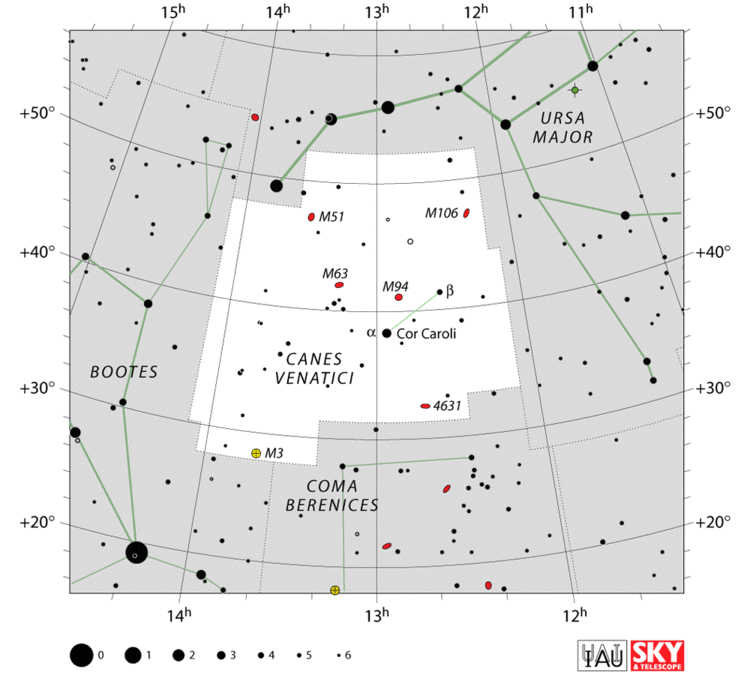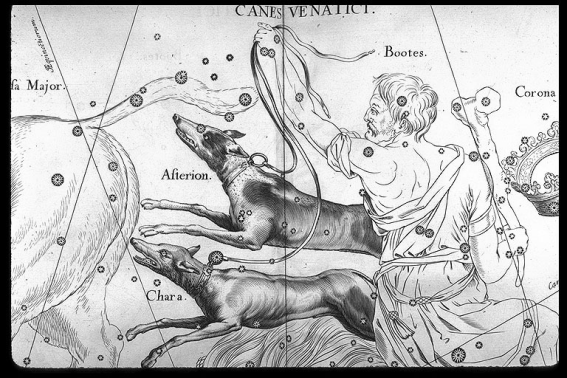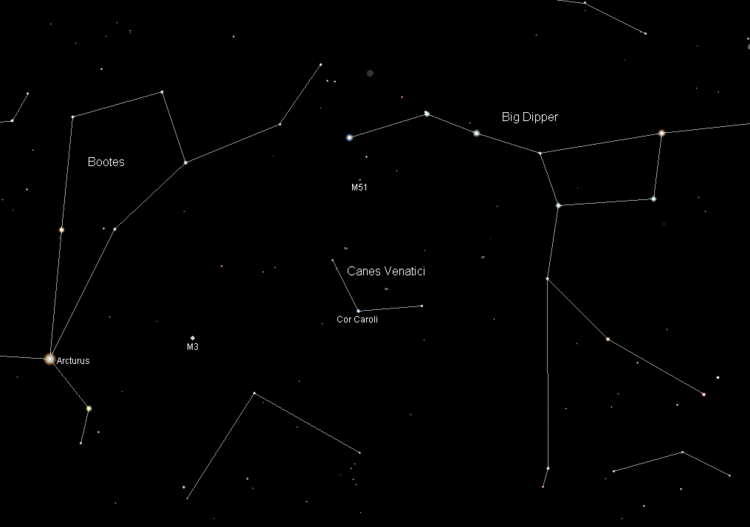Abbreviation CVn Symbolism the Hunting Dogs Declination +27.84° to +52.36° Bayer/Flamsteed designation 21 Stars with planets 4 | Genitive Canum Venaticorum Right ascension 12 06.2 to 14 07.3 Main stars 2 Messier object 5 | |
 | ||
Pronunciation /ˈkeɪniːz vᵻˈnætᵻsaɪ/ Cánes Venátici, genitive /ˈkeɪnəm vᵻnætᵻˈkɒrəm/ Similar | ||
Galaxy m106 canes venatici honic psi
Canes Venatici /ˈkeɪniːz vᵻˈnætᵻsaɪ/ is one of the 88 official modern constellations. It is a small northern constellation that was created by Johannes Hevelius in the 17th century. Its name is Latin for "hunting dogs", and the constellation is often depicted in illustrations as representing the dogs of Boötes the Herdsman, a neighboring constellation.
Contents
- Galaxy m106 canes venatici honic psi
- Canes venatici meaning
- History
- Characteristics
- Stars
- Supervoid
- Deep sky objects
- References

Canes venatici meaning
History

The stars of Canes Venatici are not bright. In classical times, they were listed by Ptolemy as unfigured stars below the constellation Ursa Major in his star catalogue.

In medieval times, the identification of these stars with the dogs of Boötes arose through a mistranslation. Some of Boötes's stars were traditionally described as representing the club (Greek, Κολλοροβος) of Boötes. When the Greek astronomer Ptolemy's Almagest was translated from Greek to Arabic, the translator Hunayn ibn Ishaq did not know the Greek word and rendered it as the nearest-looking Arabic word, writing العصا ذات الكلاب in ordinary unvowelled Arabic text "al-`aşā dhāt al-kullāb", which means "the spearshaft having a hook". When the Arabic text was later translated into Latin, the translator Gerard of Cremona mistook the Arabic word كلاب for kilāb (the plural of كلب kalb), meaning "dogs", writing hastile habens canes ("spearshaft having dogs"). In 1533, the German astronomer Peter Apian depicted Boötes as having two dogs with him.

These spurious dogs floated about the astronomical literature until Hevelius decided to specify their presence in the sky by making them a separate constellation in 1687. Hevelius chose the name Asterion (from the Greek 'αστέριον, meaning the "little star", the diminutive of 'αστηρ the "star", or adjective meaning "starry") for the northern dog and Chara (from the Greek χαρά, meaning "joy") for the southern dog, as Canes Venatici, the Hunting Dogs, in his star atlas. In his star catalogue, the Czech astronomer Bečvář assigned the names Asterion to β CVn and Chara to α CVn.
Characteristics
Canes Venatici is bordered by Ursa Major to the north and west, Coma Berenices to the south, and Boötes to the east. The three-letter abbreviation for the constellation, as adopted by the International Astronomical Union in 1922, is 'CVn'. The official constellation boundaries, as set by Eugène Delporte in 1930, are defined by a polygon of 14 sides. In the equatorial coordinate system, the right ascension coordinates of these borders lie between 12h 06.2m and 14h 07.3m, while the declination coordinates are between +27.84° and +52.36°. Covering 465 square degrees, it ranks 38th of the 88 constellations in size.
Stars
Canes Venatici contains no bright stars, α and β CVn being only of 3rd and 4th magnitude respectively. Flamsteed catalogued 25 stars in the constellation, labelling them 1 to 25 Canum Venaticorum, however 1 turned out to be in Ursa Major, 13 was in Coma Berenices and 22 did not exist.
Supervoid
The Giant Void, an extremely large void (part of the universe containing very few galaxies) is within the vicinity of this constellation. It may be possibly the largest void ever discovered, slightly larger than the Eridanus Supervoid and 1,200 times the volume of expected typical voids. It was discovered in 1988 in a deep-sky survey.
Deep-sky objects
Canes Venatici contains five Messier objects, including four galaxies. One of the more significant galaxies in Canes Venatici is the Whirlpool Galaxy (M51, NGC 5194) and NGC 5195, a small barred spiral galaxy that is seen face on. This was the first galaxy recognised as having a spiral structure, this structure being first observed by Lord Rosse in 1845. It is a face-on spiral galaxy 37 million light-years from Earth. Widely considered to be one of the most beautiful galaxies visible, M51 has many star-forming regions and nebulae in its arms, coloring them pink and blue in contrast to the older yellow core. M51 has a smaller companion, NGC 5195, that has very few star-forming regions and thus appears yellow. It is passing behind M51 and may be the cause of the larger galaxy's prodigious star formation.
Other notable spiral galaxies in Canes Venatici are the Sunflower Galaxy (M63, NGC 5055), M94 (NGC 4736), and M106 (NGC 4258). M63, the Sunflower Galaxy, was named for its appearance in large amateur telescopes. It is a spiral galaxy with an integrated magnitude of 9.0. M94 is a small face-on spiral galaxy with an approximate magnitude of 8.0, about 15 million light-years from Earth. NGC 4631 is a barred spiral galaxy, which is one of the largest and brightest edge-on galaxies in the sky.
M3 (NGC 5272) is a globular cluster 32,000 light-years from Earth. It is 18' in diameter, and at magnitude 6.3 is bright enough to be seen with binoculars. It can even be seen with the naked eye under particularly dark skies.
M94, also classified as NGC 4736, is a face-on spiral galaxy 15 million light-years from Earth. It has very tight spiral arms and a bright core. The outskirts of the galaxy are incredibly luminous in the ultraviolet because of a ring of new stars surrounding the core, 7,000 light-years in diameter. Though astronomers are not sure what has caused this ring of new stars, some hypothesize that it is from shock waves caused by a bar that is thus far invisible.
